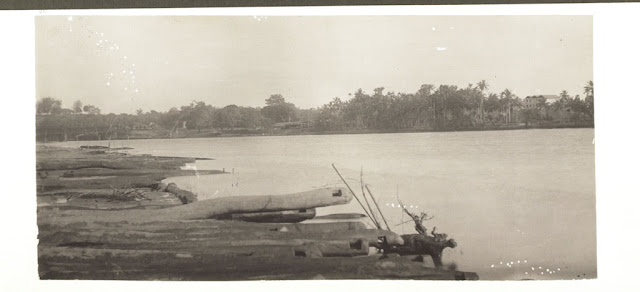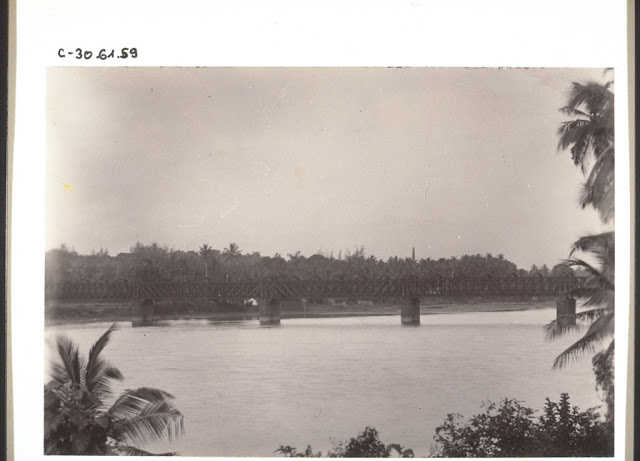The spread of Jainism to Wayanad
The spread of Jainism to Kerala is from Karnataka and Tamil Nadu. Jainism was a
stronghold in Karnataka especially in Sravana Belgola during the reign of
Chandragupta. Chandragupta was a great promoter of Jainisrn and sent many missionaries to the different parts. Among them, somebody came to Kerala and spread Jainism here. This is considered to be the first Jain migration to
Kerala. Another group of Jains migrated to Kerala around the 8th century from
Tamil Nadu.
Many
relics and studies prove the existence of Jainism in Kerala. The remaining of the Jain temples and the images of Tirthankaras have been found from different parts of Kerala. Though there were a number of Jain temples in the past, many of
these temples were converted into Hindu temples.
Chithral,
a place in Tamil Nadu, was a part of Kerala decades ago. It is said that the
Saraswathi Kshethram in Chithral was a Jain temple till 13th century. The temple
is situated on a huge rock near cave. This cave is said to have been used by
Jain monks, because on the walls of the cave the Tirthankaras images have been engraved. Apart from that, the idols of the 23rd and 24th Tirthankaras are erected in the sanctum sanctorum of the temple. From these facts, there is no doubt to assume that Chitharal Saraswathi Kshethram was a Jain
temple.
Nagaraja
Swami Kshethram, situated in Nagarcovil, was a part of Travancore is said to be
a Jain temple. Six Jain idols have been found from this temple. Mahavira's and
Parsvanatha's idols are still being kept in the temple. Palakkad was an
important jain centre in the past. Chandraprabha Kshethram (Chandrapraha is the
8th Tirthankara) is a Jain temple. The place where the temple is situated is
known as 'Jain Medu' presently there is only one Jain family in
Palakkad.
Temples converted into Hindu temples
According
to Archaeological department, Irinjalakuda Bharataswamy Kshethram is a Jain
temple. Now this temple is worshipped by Namboodiries. Bharath was the eldest
son of Rishabha Deva, the first Tirthankara of Jains. The Kallil Baghavathy
Kshethram at Muvattupuza is a Jain temple, which is also worshipped by Hindus.
The idols of Mahavira and Parsva Natha arc seen in these temples.
Apart
from these temples many other temples also have been converted into Hindu
temples. Jains were one of the civilized groups in Kerala. But in course of time
the invasion of Saiva and Vaishnava religions declined the influence of Jains in
the community. Many Jain kings were converted into these religions. This is
said.to be the reason for the decline of Jainism. In the present. day the main
Jain centres in Kerala are: Eranakulam, Calicut and Wayanad. The Jains of
Eranakulam and Calicut are belonging to the Svetambara sect and most of them
have become successful business men. In Wayanad Jains are mainly farmers and
business men. Among these places Wayanad is the most important Jain
centre.
Jainism in Wayanad- Bailnad
Bailnad
According
to the ancient history of Wayanad Jains are the first group who migrated to
Wayanad. The Kannada speaking people in Wayanad are known as Jains, they belong to the Digambara sect and they are called Gowadas. Hoysala kings were the rulers
of Kamataka'in the 12th century and Wayanad was a part of Karnataka. At that time Wayanad was known as Bailnad. The rulers of Hoysala Dynasty were Jains till
Vishnuvardha. Around the medieval period, Saiva religion became a stronghold in
Karnataka and the frequent attacks from Salva religion to Jain lead to the migration of Jains to Kerala and especially to Wayanad.
Panamaram
The
migrated Jains first came to Panamaram on the banks of Kabini river. From there the Jain groups spread to the different parts of Wayanad. These Jains were
basical1y farmers. Digging and ploughing were against their belief. So as to keep their belief they introduced eco-farming in Wayanad. Jainism was in its peak in Wayanad during the days of Hoysala Dynasty. Hoysala kings promoted
Jainism and they sent many missionaries to the different parts to spread
Jainism. There are many proofs, which justify the existence of Jainism in
Wayanad. The history tells us that the Bathery Jain temple was built 800 years ago.
Hennaredu Bedhi
 |
| 1911 |
 |
| 2011 |
Earlier
this temple was known as Kidangad Basti and the older name of Bathery was
Hennaredu Bedhi (twelve streets). These two names are Kannada names and it shows
the influence of the Kamataka Jains. Some other similar place names are:
Bennagode (Venniyode), Palagonthu (Palukunnu), Muthangadi (Puthangadi), and
Hosengadi (Mananthavady). All these Kannada names are the fool-proof evidence to justify the existence of Jains in Wayanad.
Edakkal Caves
It
is believed that the wall inscriptions in Edakkal Caves (the oldest historical
monument in Wayanad) are closely related to Jainism. The Swastik mark, the mark
of the seventh Tirthankara, Suparswa Natha, has been engraved on the wall. The
Chandrabimbamark, the mark of the eighth Tirthankara, Chandra Natha, also can be
seen on the wall of the cave. The other inscriptions on the wall are the Hoysala
kings'. The former Hoysalas were Jains.
Influence of the Hindu religion
In
the thirteenth century Jainism was in its peak in Wayanad. By the end of
eighteenth centuiy the religion became too weak because of the increasing
influence of the Hindu religion and the invasion of Saiva - Vaishnava religions.
In this period many Jain temples were destroyed and some of them were possessed
by Hindus. The relics of these ruined temples can be seen in Bathery, Puthangadi
and Poothadi.
Jain population in Wayanad
At
present Wayanad is considered to be one of the important Jain centres. According
to the latest survey the total Jain population in Wayanad is 1581. Among them
797 are male and 784 are female. In Wayanad the main Jain centers are:
Mananthavady, Panamaram, Anjukunnu, Varadoor, Kalpetta and
Kaniyambatta.
The Jain Community in
Wayanad
The Jain Community in Wayanad has been divided into
nine units. In one unit there are nine committee members. Among them seven
members are the Directors of the committee and the remaining two members are
Chairman and Convener. The nine units are:
a) Anjukunnu Unit : The Anjukunnu Unit
consists of thirty-seven families and the total number of members is 147. Among
them seventy-four are married. There are seventy-one male and seventy-six female
in the unit. Most of the Jains in this area are farmers. Apart from farmers
there are teachers and employees.
b). Kalpetta Unit : In Kalpetta unit
there are sixty-three families and it has the strength of 249 members 137 are
married. The number of male are 131 and female are 118. The noted writer,
cultural critic and former Union Minister Mr. M.P. Veerendrakumar, belongs to
this unit.
c) Kaniyambatta Unit : The Kaniyambatta
unit consists of fifty-two families and the number of members are 236. Among
them 126 are married. There are 128 male and 108 female in the unit. The members
of Kaniyambatta unit are basically fanners. Some of them doing business and most
of the youth are doing their higher studies in different branches.
d) Karinkutty Unit : The total number of
families in Karinkutty unit are twentynine. The total number of members is 116.
Among them fifty-six are male and sixtyare female. Sixty-six members are
married.
e) Muttile Unit : There are forty-three
families in Muttil unit and it has the strength of 157 members. There are
seventy-seven male and eighty female members. Among them eighty members are
married.
f) Neervaram Unit : Neervaram
unit consists of fifty-eight families and the total number of members is 211.
There are 101 male and the remaining 110 are female. The number of married is
102.
g) Poothadl Unit: There are forty-nine families and 163 members in this unit. Among them seventy-two are male and ninety-two are married.
g) Poothadl Unit: There are forty-nine families and 163 members in this unit. Among them seventy-two are male and ninety-two are married.
h) Puthlyidam Unit : Puthiyidam Unit
consists of thirty-two families and 126 members. There are sixty-seven male and
fifty female members. Among them seventy are married.
i) Vennlyode Unit : Venniyode
unit comprises forty4hree families and 176 members. Among these members
seventy-five are married. There are ninety-four male and eighty-two
female.
All
these nine units function with a view to uplift the standard of living of the
Jains in the community. Most of the Jains are rich enough and have achieved a
social status in the society. As far as some other Jains are concerned even now
they are in the lower shelves. These Jain units try to occupy a better position
and sphere for them.
Jain Temples in Wayanad
1. Sulthan Bathery Jain temple :
This is an ancient Jain temple situated at Sultan Bathery town. It is supposed to have been built around twelfth century A.D. The temple was taken over, by Tippu sultan and used as the Battery for his army. It is now under the possession of Archaeology Department who repaired the temple in 1996. Though this temple surroundings had a large Jain population in ancient times, there are no Jains in this area now. On the pillars and on the walls of the temple are engraved with the images of Tirthankaras. One of the specialities of this temple is that no piece of wood is used for the construction of the temple even the roof of the temple is made of stones. The Wayanad Jain community conducts a Navakhalasha Panchamritha Abhisheka Pooja at this temple on the occasion of Mahaveer Jayanthi every year.
2. Sri Adblswara Swami Temple, Manantbavady :
This is temple situated about 1 k.m. from Mananthavady. It is supposed to be centuries old. In 1960 the hereditary custodian Late
Shri.D.Padmaja Tharakan handed over the temple to a trust, which was formed with
Late Shri. Palukkunnu Chandrayya Gowder as President. The temple was renovated in 1958 and Pancha Kalyana was conducted.
3. Anandapuram Shrl. Adblshwara Swami Temple, Puthlyadam
: This temple is situated about eight k.ms from Mananthavady
town. It was constructed in 1957 and Pancha Kalyana Prathista Mahotsava was conducted in June of the same year.
4. Shri. Ananthanatha Swamy Temple, Ananthakrlshnapuram :
This is one of the main Jain temples of Wayanad. It was situated in a place called Kalpavathy or old Kalpetta. It was originally managed by the
Uralan Shri. Payappa Tharakan after whom the management was taken over by Sri.
P.C. Mandapa Gowder in 1926, who formed a trust to manage the temple in 1931.
This temple, which was dilapidated, was shifted and newly constructed at a place called Ananthakrishna Puram and Pancha Kalyana Mahotsava conducted in 1933 under the Leadership of Late Shri. M.K.Subbiah Gowder and then by Late Shri. M.
K.Ananthayya Gowder. Presently the temple is situated on the Kalpetta
Mananthavady road about five k.ms from Kalpetta town.
5. Shri. Ananthanatha Swamy Kshethram, Varadoor :
This Jain temple was originally situated at Arapatha near
Echome. It was shifted to Kottavayal, and from there again to its present near
Varadoor in. 1964. the temple was constructed under the leadership of late
Shri.V. K. Vardhman Gowder. Panchakalyana Mahotsva was conducted in 1977 when the present idol was installed. A copper inscription has been found in this
temple. And this inscription reads that, "Lalithappan son of a Karnataka king,
came to Wayanad 300 years ago and donated valuable things to all the Jain
temples." The temple is run by a trust, formed in 1953 by late V.P. Ananthayya
Gowder.
6. Shri. Chandranatha Swamy Temple, Puthanangadi :
This is one of the ancient Jain temples of Way an ad. A number of old and dilapidated ruins of other Jain temples are found around this temple.
This temple is situated on the Panamaram - Nadayal road about five kilometres
from Panamaram town. This place was originally known as Mannikapuram and was
supposed to be a centre of trade in gems and pearls. In course of time this name was changed to Muthangadi and now as Puthanangadi. In 1950 a trust was formed to
develop this temple under the leadership of late Shri. Ramachandra Gowder of
Neervaram who renovated the temple. Later a new idol was installed and
Panchakalyan was conducted in 1958 leadership of late Shri.M. V. Jinachandra
Gowder.
7. Shri. Parsva Natha Swamy Kshethram, Anjukunnu :
This is a newly constructed temple in 1996. The Panchakalyana
Prathishta Mahotsva was conducted in the same year. It is situated about three
kilometers from the Kalpetta - Mananthavady main road at a place called
Anjukunnu.
8. Shri. parsva Natha Swami Kshethram, Palukunnu :
This is another oldest Jain temple in Wayanad. The temple is
situated at Palukunnu, which is about six kilometers away from Anjukunnu on
Mananthavady - Kalpetta main road. It was renovated in 1950 by Kalathingal
Krishna Gowder. About three decades back Parsva Natha Swami Kshetra trust was
formed. The current President is Shri P.M. Vardhamanan.
9. Shrl. Shanthl Natha Swamy Devaswom, Vennlyode :
This is a very old Jain temple of Wayanad. The temple was run and managed by the hereditary 'Uralans'.
a. Thazheveettil Shri. ShanthaIj Tharakan
b. Shri. Brahma Soori Tharakan
c. Shri. M.P.C. Jain
d. Venniyodc Shri. Dcvaraj Tharakan
a. Thazheveettil Shri. ShanthaIj Tharakan
b. Shri. Brahma Soori Tharakan
c. Shri. M.P.C. Jain
d. Venniyodc Shri. Dcvaraj Tharakan
These
'Uralalns' (hereditary custodians) handed over the temple to a trust consisting
of twelve members on May 1955. in 1964 the temple was renovated and Panchakalyan
was conducted under the leadership of Late Shri M. K Jinachandran. Earlier to
this a Panchakalyana was conducted in 1928 under the leadership of Sargur Shri
Chandra Sagara Swmaji. The annual pooja of this temple is conducted on Vaishaga
Shuklanavami. The present temple is managed by a trust under the president ship
of Shri. MJ. Vijayapadman. The temple is situated about eight kilometers from
Kambalakkad town.
10. Chandranatha Girl Kshethram : This
temple is situated on top of a single huge rock called Myladipara near Kalpetta.
There was a huge idol of Chandranatha Tirthankara, which was worshipped in
earlier times. This idol was destroyed by miscreants and only remnants of it remain today. A number of caves are situated behind the rock, which was used by
Jain monks in earlier times. A temple renovation committee was formed about
three decades ago under the Presidentship of M. S. Padmiah Gowder and later
Shri P.M. Vardhamana took over the Presidentship. A pooja is conducted during
March/April every year in which all the community members participate
The Contributions of Jain Community to
Wayanad
One of the main contributions of Jainism is that the introduction of eco-friendly cultivation in Wayanad. Jains were against the digging and ploughing of the land. So as to keep their belief they did not plough or dig the land. In the field of irrigation, Jains have contributed a lot. Some of the dams and ponds built by Jains still exist in: Cheeral, Kazhampukunnu, Nambiarkunnu, Chulliyode, Kolliyadi, Thaloor, Sultan Bathery, Meenangadi, Panamaram, Anjukunnu and Nadavayal. These ponds and dams were built in the medieval period. The Jains of that time used to store water in these ponds, dams and irrigated the crops. Doddappan Pond, near Sultan Bathery is one of those kinds. These ponds and dams, adjourned to the Jain temples were not only for the exclusive use of the temples but also for the use of men and animals.
One of the main contributions of Jainism is that the introduction of eco-friendly cultivation in Wayanad. Jains were against the digging and ploughing of the land. So as to keep their belief they did not plough or dig the land. In the field of irrigation, Jains have contributed a lot. Some of the dams and ponds built by Jains still exist in: Cheeral, Kazhampukunnu, Nambiarkunnu, Chulliyode, Kolliyadi, Thaloor, Sultan Bathery, Meenangadi, Panamaram, Anjukunnu and Nadavayal. These ponds and dams were built in the medieval period. The Jains of that time used to store water in these ponds, dams and irrigated the crops. Doddappan Pond, near Sultan Bathery is one of those kinds. These ponds and dams, adjourned to the Jain temples were not only for the exclusive use of the temples but also for the use of men and animals.
Paddy cultivation
Jains
were experts in paddy cultivation and they introduced it in Wayanad. Like that
the introduction of pepper and Robesta Coffee were the contributions of Jains.
Another important contribution of Jains is in field of architecture. Most of the ancient Jain temples are in the Vijayanagara style. The temples have
Mukhmandapa, Garbhagriha, Ardhamandapa and Mahamandapa. Sultan Bathery Jain
temple is built in the same style. One of the specialities of this temple is that for the construction of the temple no piece of wood has been used, even the
roof of the temple is made of stones. The engravings in the Puthanangadi Jain
temple deserve a special mention here. Along with the Jain statues, the images
of Matsya, Kunna and Varaha images too can be seen on the walls of this
temple.
Jains
are the first group who started social life in Wayanad. Centuries ago they
migrated and started living together. The older name of Sulthan Bathery was
'Hennaredu Bedhi', which means 'twelve streets'. This is a Kannada name and the
migrated Jains were from Karnataka. History and the name 'Hennerdu Bedhi' tell
us that there were twelve well organized streets and it was the main centre of
Jains. Thus Jains paved the way for the social life in Wayanad.
Important Personalities and Their Contributions :
Shri.M.K.Jinachandran is considered to be the founding father of
modern Wayanad. He was a great visionary and he did many things for the
development of Wayanad and its people. He started the first High School in
Wayanad, S.K.M.J.High.School, Kalpetta, which is considered to be one of the
premier educational institutions in Wayanad. He also established fifteen L.P and
U.P, Schools in Wayanad. For the development of the S.C and S.T sections he
started a 'Kanyagurukulam'. Late Shri Ragavan Master, former MLA of Wayanad was
a student of 'Kanyagurukulam'. The first to introduce telephone in the district
is Shri. M K. Jinachrtdran who also introduced post offices here. He started the
first petrol pump and vehicle service station.
Shri.
Maniamkode Krihshna Gowder,a committed freedom fighter, is another important
figure, who has contributed much in the fields of agriculture. He introduced
Robesta Coffee in Wayanad; its seeds were brought from Africa. He made every
endeavour to bring Gandhiji to Wayanad. As a result of his efforts Gandhiji came
to Wyanad on January 14th, 1943. Palukunnu Chandrayya Gowder is another
philanthropist, worked for the welfare of the people. He donated land and
building for the inception of a Government Hospital in Panamaram. He started the
Gandhi Memorial U.P School in Anjukunnu. Presently it is run by Christian
management. Sri.V.K. Vardhamana Gowder started co-operative societies and banks
in Wayanad. He also donated land for the veterinary hospital in Vardoor. Shri.
M.P.Chandranathan, Sri. Vijayapadman, Shri Mandappa Gowder, Koottamunda Subbya
Gowder, Shri. M. K. Padmaprabha, Shri M. P. Veerendra Kumar, are the other
personalities who dedicated their life for the development of Wayanad. All these
personalities donated a lione share of their money and land to uplift the people
of Way an ad as well as the growth of Wayanad.
























 TITLE AND DATE NOT AVAILABLE, PROBABLY FEREOKE, AND CHALIYAR CALICUT
TITLE AND DATE NOT AVAILABLE, PROBABLY FEREOKE, AND CHALIYAR CALICUT







.jpg)
.jpg)








